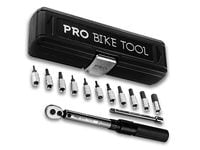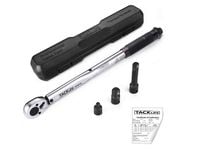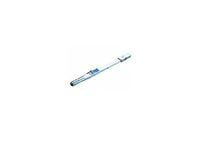The heaviest torque loads in motorcycle assembly are large-diameter fasteners such as flywheel, primary-drive, and axle nuts. For these, a 1/2-inch torque wrench is good. Then, for general use, such as triple-clamp bolts and cylinder-head bolts and nuts, a 3/8-inch torque wrench suffices nicely. And for smaller fasteners, such as 6mm cam-cover and engine-case bolts, oil-filter cover bolts, and smaller fasteners, it’s no use putting on the gorilla suit and using a larger torque wrench. In fact, it can be an exercise in frustration (or even impossible) to calibrate it for lighter torque loads, and you might even wind up with snapped parts. The answer here is a 1/4-inch drive. Therefore, for motorcycle maintenance and repair, the ideal garage has three different torque wrenches with sockets or adapters to match. Here are good solutions in 1/4-, 3/8-, and 1/2-inch-drive sizes.
Designed to handle torque loads of 2–20 Newton-meters (about 1.5–15 pound-feet) on motorcycles and bicycles, this multitool includes hexagonal Allen and the less common star-shaped Torx bits, an extension bar, and storage box. Fortunately, the wrench can also torque traditional bolts and nuts; just attach the appropriate 1/4-inch-drive sockets or an adapter and 3/8-inch-drive sockets (not included). Having a light touch with a wrench like this is great for fragile components such as instruments, carburetors, and ignition systems.
True story: Overtorqueing a steel bolt in a Cycle World staffer’s late-model motocross bike’s aluminum dry sump was a $200 error that could have been avoided with a torque wrench like this. And so, if becoming a precision mechanic hasn’t driven you to use a torque wrench, maybe economics of not using one will! It sure did for us. This 3/8-inch-drive wrench is settable from 10–80 pound-feet, which is most everything you’ll find on a typical motorcycle. The wrench set includes a box, 1/4-, and 1/2-inch adapters, plus an extension bar.
In order to keep their calibration sharp, ordinary click torque wrenches need to be “turned down” (their spring-loaded adjustment handles slacked off) after use. But this split-beam torque wrench from Precision Instruments doesn’t require this step. To use it, just flip up the adjustment cover, turn the thumb wheel to the desired torque, and go to work. Afterward, you never have to “turn down” the wrench. Torque settings on this heavy-duty model range from 40–250 pound-feet, making it useful for everything from crankshaft nuts to motorcycle axles…and dually pickups!



/cloudfront-us-east-1.images.arcpublishing.com/octane/NZKPFUWBHVGYJAFQPCXWAK6BZM.jpg)
/cloudfront-us-east-1.images.arcpublishing.com/octane/K5ZSQFMYQZHWRFXTTW4PEWMUDM.jpg)
/cloudfront-us-east-1.images.arcpublishing.com/octane/D2SOSBIQQRBPTERNSOJRAW3KYY.jpg)
/cloudfront-us-east-1.images.arcpublishing.com/octane/DS3Q5X2VJFFAJDK2PWB3Y7K6U4.jpg)
/cloudfront-us-east-1.images.arcpublishing.com/octane/4KBL4JAMYRFDPEINTWATDUH7OM.jpg)
/cloudfront-us-east-1.images.arcpublishing.com/octane/FXADK3MVSNBRTKJ2B7TPDCCJ5Y.jpg)
/cloudfront-us-east-1.images.arcpublishing.com/octane/M7L2CPXO55FRFMECW7QGDPGP6E.jpg)
/cloudfront-us-east-1.images.arcpublishing.com/octane/T4RWGLAEHVE2VCJZOTFTNGB2KA.jpg)
/cloudfront-us-east-1.images.arcpublishing.com/octane/JM4QGLAHWNGHPM74OEB7FVBFSY.jpg)
/cloudfront-us-east-1.images.arcpublishing.com/octane/BGPNXPDDYBHD3HL6YEZQOYHXTI.jpg)
/cloudfront-us-east-1.images.arcpublishing.com/octane/SND5GGQV4RDPPMZBSBEGIZ4SIY.jpg)
/cloudfront-us-east-1.images.arcpublishing.com/octane/XUDDAPYZMZEL5EDPVDJ2DTULWI.jpg)
/cloudfront-us-east-1.images.arcpublishing.com/octane/M7AU2L6GAVCJVHW57LIRPDAAUQ.jpg)

/cloudfront-us-east-1.images.arcpublishing.com/octane/JKEJY7P43JGD5C5NJO2VJQJPUM.jpg)
/cloudfront-us-east-1.images.arcpublishing.com/octane/YROKYJYUQVGPHCEMPTGBWDQCKQ.jpg)
/cloudfront-us-east-1.images.arcpublishing.com/octane/QIHEYR66TZDAPCGMWHCWCBC4XA.jpg)
/cloudfront-us-east-1.images.arcpublishing.com/octane/4FTBMNZL5BD2ZHY62XXRHJW6PI.jpg)
/cloudfront-us-east-1.images.arcpublishing.com/octane/L2BHKRCEMFDF7O3S4REZXPDH2E.jpg)
/cloudfront-us-east-1.images.arcpublishing.com/octane/QHENIV3HMJCTTCXQ6O5YPTNRZ4.jpg)
/cloudfront-us-east-1.images.arcpublishing.com/octane/K3VNQBIAKVGIHIGBRG7QKJYLVI.jpg)
/cloudfront-us-east-1.images.arcpublishing.com/octane/HRU64QXT3NH2DJOFBVI53XIKCE.jpg)
/cloudfront-us-east-1.images.arcpublishing.com/octane/4C5HHSNJCVDZXPIJTCJBVTE2MU.jpg)
/cloudfront-us-east-1.images.arcpublishing.com/octane/HBKK2TCOCZFIBIVKLKZFF5NXLQ.jpg)